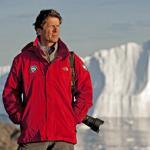20 December 2010

Photo: James Balog/Extreme Ice Survey
James Balog photographing ice diamonds in Iceland (July 2008)
James Balog's extraordinary photographs are a window on the world's endangered wildlife, melting glaciers and disappearing landscapes. The self-taught artist began his craft with a passion for nature.
The son of a Wall Street financier and a housewife, Balog grew up in the 1950s wandering about the forests of western New Jersey with his friends.
"We'd stay out there for weeks in a little lean-to that we built," he says.

Adam LeWinter
James Balog, pictured here in Greenland, has designed, programmed and installed time-lapse cameras on glaciers to record the impact of a warming climate.Bold move
While a geology student at Boston College, Balog became an avid adventurer, honing his wilderness skills on America's rugged mountains, wild rivers and back country trails. After graduation he continued his education at the University of Colorado in geomorphology, the study of how the land surface evolves over time. When it came time to find a job, he made a bold move.
"I had been dabbling in photography as a serious amateur and just this one day decided, okay, that will be a better way for me to express my enthusiasms for nature," he says.
Balog worked hard to learn the profession, read a lot and talked to people in the field, "then refining my eye through trial and error practice and getting criticism from whatever editors I could get to meet."
A big break in the early 1980s with an article for a major magazine about avalanches gave him his start. That led to dozens of environment-related news stories and established his reputation as a top-notch nature photographer. "I've had more adventure than I ever could have hoped for or ever could have imagined," he says.

James Balog
For his book 'Tree: A New Vision of the America Forest,' James Balog snapped this picture of a Giant Sequoia while rappelling down from the canopy.Pursuing his vision
Success has given Balog the freedom to pursue his own ideas in a half-dozen photography books. In "Survivors," he focuses on endangered species in captivity, portraying them against sterile white backgrounds. He poses a mandrill on a stool, an Atlantic Green Sea Turtle belly up on a white cushion and shoots a close-up of a rhino's hind end. Balog says the white backgrounds underscore the animals' endangered status. "Instead of putting them in the habitats that look romantic and beautiful as if Nature's going to go on forever, it actually symbolized the fact that animals are becoming ever more rare because habitat is being destroyed."
"Tree: A New Vision of the American Forest" is also a book of portraits. Balog says it was the closest he could come to reassembling the country's primeval forests. Roped among these giants, he took pictures while rappelling down from the forest canopy.

James Balog
James Balog photographs a rhinoceroses in a stark white background to underscore its endangered status."I would stop at a given place, and I would try to photograph what the tree looked like at that level. And sometimes it would be 10, sometimes 15, 20 shots across that level." Balog then digitally edited them into dramatic panoramas of trees in profile.
Moving picture of climate change
In his latest project, Balog focuses on melting glaciers. In 2006 he founded the Extreme Ice Survey and serves as its executive director. The nonprofit has deployed 39 cameras on 17 glaciers in Alaska, Greenland, Iceland and the Rocky Mountains that take pictures hourly during daylight hours. What's emerged from the approximately 4,500 photos from every camera each year is a moving picture of climate change.

James Balog
The glaciers feeding these icebergs in southeast Iceland have steadily pulled back since the 1930s, leaving an 8-kilometer wide lagoon."It's not an abstraction. It's not about a computer model. It's not about statistics. It's not about what might happen in the future," says Balog. "It's right here right now, and you get it when you look at these pictures."
EIS supplements this record with annual repeat photography in these locations and in the Alps, British Columbia, Canada, Bolivia and the Himalaya.
Balog's lifetime of achievements was honored recently with the 2010 Heinz Award, a prestigious environmental prize. His latest adventure on ice has given him a sense of the fragility of the global environment and why it is urgent to protect it.
"At some deep elemental level humans understand what it means when ice goes away," Balog says. "And that's what we're recording here. So I want people to take that to heart and understand that climate change is real and they can do something about it."